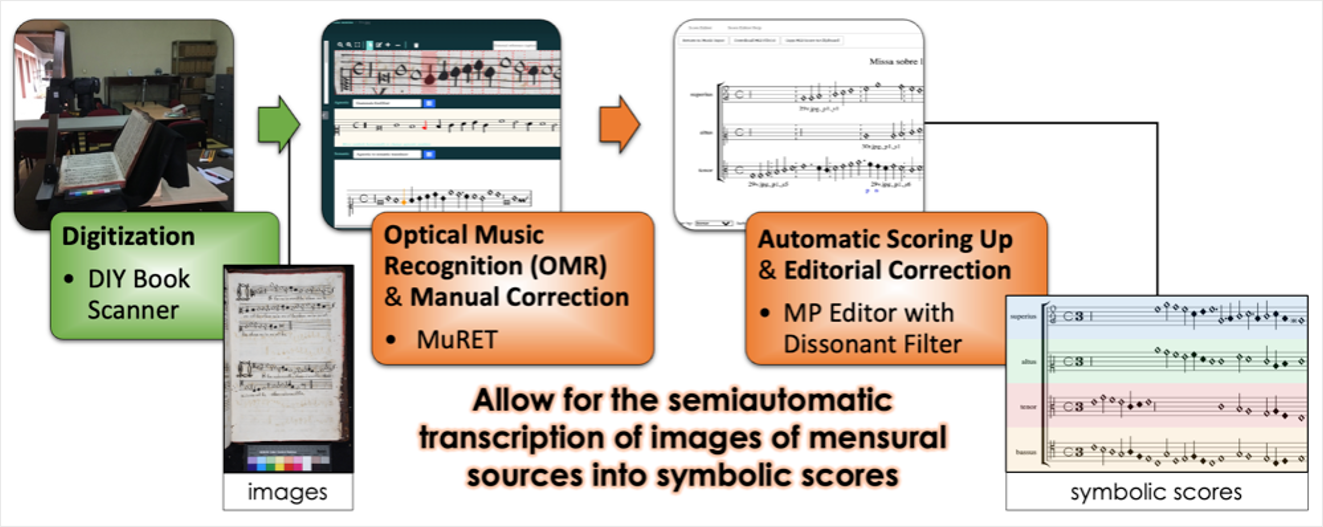Updates and Outcomes from the Guatemalan Digitization and Encoding Project
Authors: Thomae, Martha E. / Cumming, Julie / Fujinaga, Ichiro
Date: Friday, 8 September 2023, 9:15am to 10:45am
Location: Main Campus, L 2.202 <campus:measure>
Abstract
In this paper, we are presenting the outcome of a four-year music-encoding project. Four years ago, at the Music Encoding Conference, we presented our plans for digitizing and encoding a mensural music corpus in Guatemala City. Six large sixteenth-century polyphonic choirbooks, copied during the Spanish colonial period, are held at Guatemala City’s Metropolitan Cathedral. The plan presented consisted of a workflow for obtaining digital images and Mensural MEI files for these sources and said workflow was to be tested on one of the books (choirbook 1). The MEI files would encode the piece in score layout, allowing readers to appreciate the polyphonic texture of the music, which is obscured by the choirbook layout of the original sources where the voices are kept apart. Of course, the original workflow changed over four years, with some tools added and others replaced. In this paper, we present the updated workflow and the project outcomes to be used as a reference for other digitization and encoding projects, especially for those with limited resources.
The workflow has three steps: digitization, optical music recognition (OMR), and automatic voice alignment. Figure 1 shows these steps and the tools involved in each of them. The first step required building a do-it-yourself (DIY) book scanner, given that the archive lacked the appropriate digitization equipment for rare books. The other two encoding steps involved using free online software: MuRET and the Measuring Polyphony (MP) Editor.

This paper is meant to provide the big picture of the workflow (with additional references for further details on its specific components), present updates and results (i.e., the digital images and Mensural MEI scores), and obtain feedback from the MEI/TEI community.
Bibliography
Desmond, Karen, Andrew Hankinson, Laurent Pugin, Juliette Regimbal, Craig Sapp, and Martha E. Thomae. 2020. “Next Steps for Measuring Polyphony: A Prototype Editor for Encoding Mensural Music.” In Music Encoding Conference Proceedings 26–29 May, 2020, 121–24. Tufts University, Boston. http://dx.doi.org/10.17613/5k88-9z02.
Desmond, Karen, Laurent Pugin, Juliette Regimbal, David Rizo, Craig Sapp, and Martha E. Thomae. 2021. “Encoding Polyphony from Medieval Manuscripts Notated in Mensural Notation.” In Proceedings of the Music Encoding Conference, edited by Stefan Münnich and David Rizo, 197–219. Alicante, Spain (online): Humanities Commons. https://doi.org/10.17613/tf2j-x697.
Morales Abril, Omar. 2015. “Música local y música foránea en los libros de polifonía de las Catedrales de Guatemala y México.” Jahrbuch für Renaissancemusik: troja. Vokalpolyphonie zwischen Alter und Neuer Welt: Musikalische Austauschprozesse zwischen Europa und Lateinamerika im 16. und 17. Jahrhundert (14): 95–124.
Pujol, David. 1965. “Polifonía española desconocida conservada en el Archivo Capitular de la Catedral de Guatemala y de la Iglesia parroquial de Santa Eulalia de Jacaltenango.” Anuario Musical 20: 3–10.
Rizo, David, Jorge Calvo-Zaragoza, and José M. Iñesta. 2018. “MuRET: A Music Recognition, Encoding, and Transcription Tool.” In Proceedings of the 5th International Conference on Digital Libraries for Musicology (DLfM), 52–56. Paris, France: ACM. https://doi.org/10.1145/3273024.3273029.
Snow, Robert J., ed. 1996. A New-World Collection of Polyphony for Holy Week and the Salve Service: Guatemala City, Cathedral Archive, Music MS 4. Monuments of Renaissance Music 9. Chicago, IL: University of Chicago Press.
Stevenson, Robert. 1970. Renaissance and Baroque Musical Sources in the Americas. Washington, DC: General Secretariat, Organization of American States.
Thomae, Martha E., Julie E. Cumming, and Ichiro Fujinaga. 2022a. “Digitization of Choirbooks in Guatemala.” In Proceedings of the 9th International Conference on Digital Libraries for Musicologists (DLfM), 19–26. Prague, Czech Republic: ACM. https://doi.org/10.1145/3543882.3543885.
Thomae, Martha E., Julie E. Cumming, and Ichiro Fujinaga. 2022b. “Counterpoint Error-Detection Tools for Optical Music Recognition of Renaissance Polyphonic Music.” In Proceedings of the 23rd International Society for Music Information Retrieval Conference (ISMIR). Bengaluru, India.
About the author
Martha Thomae is a researcher at the DDMAL Lab at McGill University. She has a BS in Mathematics from Universidad del Valle de Guatemala and a Master’s and PhD in Music Technology from McGill. Her research interests include music information retrieval, early music, and cultural heritage preservation. She is working on digitizing and encoding a Guatemalan polyphonic choirbook using music-encoding technologies.
Contribution Type
Keywords